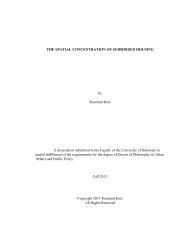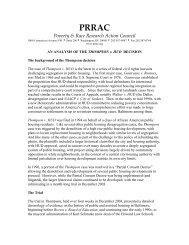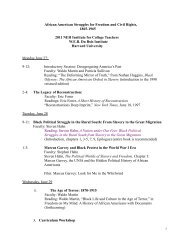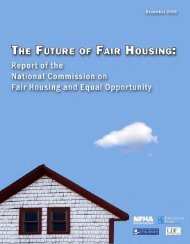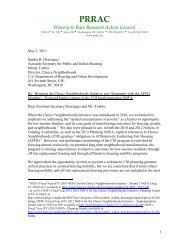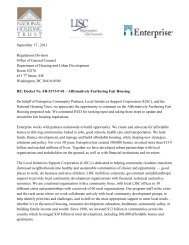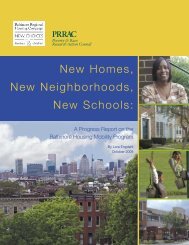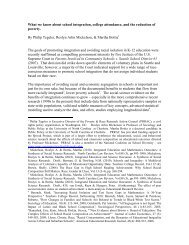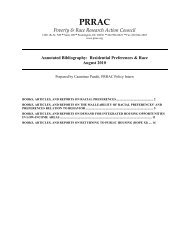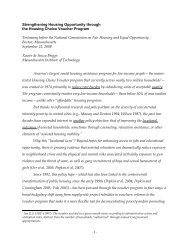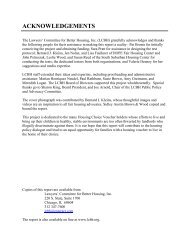Annotated Bibliography of Housing Mobility Research 2006-2010
Annotated Bibliography of Housing Mobility Research 2006-2010
Annotated Bibliography of Housing Mobility Research 2006-2010
Create successful ePaper yourself
Turn your PDF publications into a flip-book with our unique Google optimized e-Paper software.
Kling, Jeffrey R., Jeffrey B. Liebman, & Lawrence F. Katz, “Experimental analysis <strong>of</strong><br />
neighborhood effects,” Econometrica 25: 83119 (2007)<br />
Abstract:<br />
Discusses results <strong>of</strong> MTO experiment and finds that 4 to 7 years after random assignment, families<br />
<strong>of</strong>fered vouchers lived in safer neighborhoods that had lower poverty rates than those <strong>of</strong> the<br />
control group not <strong>of</strong>fered vouchers. Finds no significant overall effects <strong>of</strong> this intervention on<br />
adult economic selfsufficiency or physical health. Mental health benefits <strong>of</strong> the voucher <strong>of</strong>fers for<br />
adults and for female youth were substantial. Beneficial effects for female youth on education,<br />
risky behavior, and physical health were <strong>of</strong>fset by adverse effects for male youth. For outcomes<br />
that exhibit significant treatment effects, this report finds, using variation in treatment intensity<br />
across voucher types and cities, that the relationship between neighborhood poverty rate and<br />
outcomes is approximately linear.<br />
Ludwig, Jens & Jeffrey Kling, “Is Crime Contagious”, 50 Journal <strong>of</strong> Law & Economics 491<br />
(2007)<br />
Summary: Understanding whether criminal behavior is "contagious" is important for law enforcement and for<br />
policies that affect how people are sorted across social settings. We test the hypothesis that<br />
criminal behavior is contagious by using data from the Moving to Opportunity (MTO) randomized<br />
housing mobility experiment to examine the extent to which lower local area crime rates decrease<br />
arrest rates among individuals. Our analysis exploits the fact that the effect <strong>of</strong> treatment group<br />
assignment yields different types <strong>of</strong> neighborhood changes across the five MTO demonstration<br />
sites. We use treatment by site interactions as instruments for measures <strong>of</strong> neighborhood crime<br />
rates, poverty, and racial segregation in our analysis <strong>of</strong> individual arrest outcomes. We are unable<br />
to detect evidence in support <strong>of</strong> the contagion hypothesis. Neighborhood racial segregation<br />
appears to be the most important explanation for acrossneighborhood variation in arrests for<br />
violent crimes in our sample, perhaps because drug market activity is more common in highminority<br />
neighborhoods.<br />
Ludwig, Jens, Jeffrey B. Liebman, Jeffrey R. Kling, Greg J. Duncan, Lawrence F. Katz,<br />
Ronald C. Kessler, & Lisa Sanbonmatsu, “What Can We Learn about Neighborhood Effects<br />
from the Moving to Opportunity Experiment”, American Journal <strong>of</strong> Sociology 114(1): 14488<br />
(2008)<br />
Notes:<br />
Abstract:<br />
Part <strong>of</strong> Symposium issue on Moving to Opportunity<br />
Experimental estimates from Moving to Opportunity (MTO) show no significant impacts <strong>of</strong> moves<br />
to lower poverty neighborhoods on adult economic self sufficiency four to seven years after<br />
random assignment. The authors disagree with ClampetLundquist and Massey's claim that MTO<br />
was a weak intervention and therefore uninformative about neighborhood effects. MTO produced<br />
large changes in neighborhood environments that improved adult mental health and many<br />
outcomes for young females. ClampetLundquist and Massey's claim that MTO experimental<br />
estimates are plagued by selection bias is erroneous. Their new nonexperimental estimates are<br />
uninformative because they add back the selection problems that MTO's experimental design was<br />
intended to overcome.<br />
Ma, Fontane, “Boosting the Portability <strong>of</strong> <strong>Housing</strong> Vouchers,” PolicyMatters Journal (Spring<br />
2009)<br />
Highlights<br />
· Identifies jurisdictional boundaries as barriers to portability, and MetaLevel HAs (statewide)<br />
and regional cooperation as solutions<br />
· Results from six cities show that trends on poverty rate are generally not correlated to<br />
14



